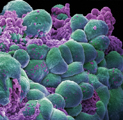


[QUEST] A paper scheduled for publication in August may quiet some of the controversy over the dangers of mercury in compact fluorescent lights (CFL). The paper, by Robert Clear, Francis Rubinstein, and Jack Howells, with Berkeley Lab’s Environmental Energy Technologies Division, shows that a person who breaks a CFL is more at risk from mercury in the environment than from the mercury in the lamp itself. The researchers say there is a distinction between the kind of mercury used in CFLs — elemental mercury — and the mercury emitted from power plant smokestacks. More>
 Stimulus Funding: New Money for Biofuel, Energy Efficiency, Nuclear Science Research
Stimulus Funding: New Money for Biofuel, Energy Efficiency, Nuclear Science ResearchAdditional funding from the American Recovery and Reinvestment Act has been announced for several new projects. JBEI will receive $4 million to purchase equipment for enhanced study of conversion of plant biomass to biofuels and the study of sorghum (pictured) as a bioenergy feedstock crop. Also, EETD has received $200,000 to provide technical assistance for the DOE’s Energy Efficiency and Conservation Block Grant Program. The Nuclear Science Division has received more than $2.5 million for two projects: one to support a staff scientist for the Nuclear Data Program Initiative and the other to upgrade the 88-inch cyclotron. For details, visit recovery.lbl.gov.
 Tech Transfer: Novartis Licenses Technology For Breast Cancer Diagnosis
Tech Transfer: Novartis Licenses Technology For Breast Cancer DiagnosisBerkeley Lab executed an exclusive license agreement with Novartis Vaccines and Diagnostics for patent-pending technology "SATB1: A Determinant of Morphogenesis and Tumor Metastasis." The SATB1 technology, developed by lead inventor Terumi Kohwi-Shigematsu in the Life Sciences Division at Berkeley Lab, showed that SATB1 protein can be down-regulated to prevent a tumor cell from becoming malignant, rendering it to be an effective prognostic and diagnostic marker for detecting aggressive cancer cells. Go here for a description of the technology.
The University of California is committed to creating and maintaining a community in which all persons who participate in University programs and activities can work together in an atmosphere free of all forms of harassment, exploitation, or intimidation, including sexual. Specifically, every member of the University community should be aware that the University is strongly opposed to sexual harassment and that such behavior is prohibited both by law and by University policy. It is the intention of the University to take whatever action may be needed to prevent, correct, and, if necessary, discipline behavior tjat violates this policy. The University of California's policy and procedures concerning sexual harassment apply to Berkeley Lab and are part of RPM 2.01(B)(4)and 2.05(E). Additional information on reporting sexual harassment may be found here.
Today at Berkeley Lab is produced by Public Affairs' Communications Department